MARK NEARY DONOHUE - 03/18/1937 - 08/19/1975

Born in Haddon Township, New Jersey, Donohue grew up in Summit, he graduated from the Pingry School in Hillside, and entered Brown University in Providence, Rhode Island. At the age of 22, while a senior at Brown, Donohue began racing his 1957 Corvette. He won the first event he entered, a hillclimb in Belknap County, New Hampshire. He graduated from Brown in 1959 with a bachelor's degree in mechanical engineering. Donohue won the SCCA national championship in an Elva Courier in 1961. An experienced race driver named Walt Hansgen recognized Donohue's ability and befriended him, eventually providing an MGB for Donohue to race at the 1964 Bridgehampton 500 mile SCCA endurance event, which he won. Hansgen arranged for Donohue to become his teammate in 1965, co-driving a Ferrari 275 at the 12 Hours of Sebring endurance race, which they finished in 11th place. That year, Donohue also won two divisional championships: in SCCA B Class in a GT350 and in SCCA Formula C in a Lotus 20B. In 1966, thanks to his friendship with Hansgen, word quickly spread to the Ford Motor Company about the young driver. Ford immediately signed Donohue to drive one of their GT-40 Mk II race cars campaigned at the 24 Hours of Le Mans by the Holman & Moody racing team. Le Mans proved frustrating for Donohue. Hansgen died while testing the GT40 in preparation for Le Mans so Donohue partnered with Australian Paul Hawkins. Donohue and Hawkins only completed twelve laps due to differential failure and finished 47th Earlier that year, co-driving with Hansgen, Donohue finished third
at the 24 Hours of Daytona and second at the 12 Hours of Sebring. At Hansgen's funeral, Roger Penske spoke to Donohue about driving for him. In his first race for Penske, at Watkins Glen in June 1966, Donohue qualified well but crashed the car at the top of a hill, destroying the car. Donohue was invited back to Le Mans by Ford in 1967. Ford had developed a new GT, the Mark IV. Donohue co-drove in the No. 2 yellow car with sports car driver and race car builder Bruce McLaren for Shelby American Racing. The two drivers disagreed on many aspects of racing and car
setup, but as a team were able to muster a fourth-place finish in the endurance classic. The race was won by Donohue's team mate duo of AJ Foyt and Dan Gurney. The win remains the sole all-American victory at Le Mans - an American-built car, prepared by an American team, and driven by American drivers - They led all but the first 90 minutes of the race. When Gurney walked onto the podium, he was handed the traditional magnum of champagne. He looked down and saw Ford CEO Henry Ford II, team owner Carroll Shelby, their wives, and several journalists who had predicted disaster for the high-profile duo of Gurney and Foyt. Many of the journalist had predicted the two drivers, who were heated competitors in the United States, would break their car trying to better one another. In that moment on the podium, Gurney shook the bottle and sprayed everyone nearby, thus

LeMans 1967
creating the champagne-spraying tradition reenacted in victory celebrations around the world over ever since. Donohue began his Trans-Am series campaign in 1967, winning three of twelve races in a Roger Penske-owned Chevrolet Camero. In 1967 and 1968, Trans-Am schedule included two of the most prized endurance races in the world, the 24 Hours of Daytona and the 12 Hours of Sebring. Donohue finished fourth at Daytona and won the Trans-Am class at the 12 Hours of Sebring. 1968 would be a banner year for Donohue in the Trans-Am series, as he
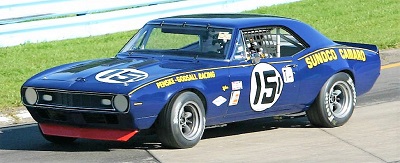
Trans-Am Series 1967
successfully defended his 12 Hours of Sebring victory by partnering with Craig Fisher and driving his Penske Chevrolet Camaro to victory. Donohue went on to win 10 of 13 races, a Trans-Am series record which would stand until Tommy Kendall went 11 for 13 in the 1997 Trans-Am championship, winning the first 11 races that year in his All-Sport liveried Mustang. Donohue was considered a leading Trans-Am driver of the late 1960s and early 1970s. His Camaros and Javelins won three Trans-Am championships (his last in 1971) while driving Cameros and
AMC Javelins, all for Roger Penske Racing. During their enormous success in success in Trans-Am, Roger and Mark would begin to experiment with their Cameros. They discovered that dipping a car in an acid bath would eat away small amounts of metal, which in turn made the car incrementally lighter, and allowed it to be driven faster around the track. The 1967 Z-28 won its last race by lapping the entire field of cars, raising eyebrows throughout the paddock. During a post-race inspection, race stewards discovered that the car was 250 pounds lighter than the 2800-pound
minimum weight requirement. Donohue was about to have his race victory taken away for cheating, but Roger Penske stepped in. Penske warned that any disqualification would have the potential of motivating Chevrolet to pull all support for the Trans-Am series. After considering the potential consequences, the race stewards allowed Donohue's victory to stand, but the rules for the 1968 season incorporated a change whereby all cars would be weighed during the technical inspection before the race. Penske and Donohue did not stop acid-dipping after this, however. Continuing the practice of reducing weight allowed them to place weights of certain sizes strategically in specific locations within the car, thus helping to balance the car while being driven on the limit. Acid-dipping car bodies was prevalent with competing Trans-Am teams as well. They continued to use the "lightweight" car in 1968,

1972 Indy 500
at the Sebring 12-hour race. They changed the grille and taillight to the 1968 model, and then painted both cars identically. They sent the legal weight car through the technical inspection with the number 15 and again with the number 16 on it. Then they put both cars in the race, number 15 and 16, one car being 250 pounds lighter They won the race, finished 3rd overall, and went on to win 10 out of 13 races that year. Donohue raced in just a few NASCAR Cup races from 1972 and 1973; all for car owner Roger Penske. His first start would come at Riverside International
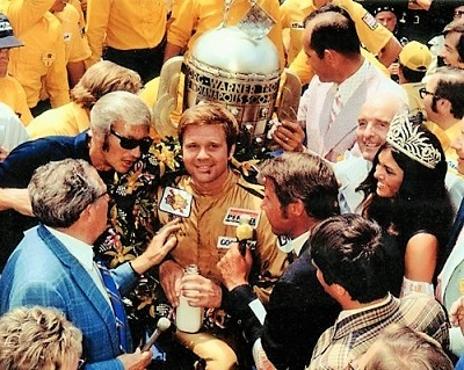
1972 Indy 500 win
Raceway. A promising beginning did not pan out. Donohue qualified third; but fell out after only 13 laps with rear end difficulties and finished 39th. He also ran in that season's Daytona 500 and the road race ace qualified the AMC Matador in the top ten. However a broken push rod would relegate him to a 35th place finish. More disappointment would follow in his next start of 1972 when he qualified seventh at Ontario Speedway in California and he would crash out after only 45 laps. He and Bobby Isaac crashed out while battling for a top ten position. Interesting fact on this race. 113 cars showed up and attempted to qualify for the race. 51 cars started the race. The fastest cars started; no provisionals. 20 fastest from first day; 20 fastest from second day and 11 fastest from third qualifying day. Just a couple of those missing the field were Charlie Glotzbach and Richard Childress. This would be AJ Foyts final career Cup win. Donohue's final start was at Atlanta where he started 11th and finished 15th. 1973 would be much better as he would again race at Riverside
and start fourth. This time he would lead 138 of the 191 laps and beat second place finisher Bobby Allison by over a lap. This was a 500 Mile race and took almost five hours to complete. It was Penske's first NASCAR win in a long history of NASCAR participation, and remains to this day the last non-regular (non-full schedule) driver (road course ringer) to win a NASCAR Cup road race. Donohue's final Cup start would come at Atlanta. He would start 12th; but erupted an engine in lap 202 of the 328 lap affair and finish 30th. In 1969, Penske and Donohue raced in their first
Indianapolis 500, where Donohue finished seventh, winning the rookie of the year award. Donohue raced at Indianapolis each year following, finishing second in 1970 and 25th in 1971. Donohue won the 1972 Indianapolis 500, driving as always for Roger Penske. He finished the race in his McLaren-Offy with a then record speed of 162 mph, which would stand for twelve years. The victory was the first for Penske in the Indy 500. Between 1971 and 1972, Penske Racing (along with Donohue as the primary test and development driver) was commissioned by Porsche to assist with development of the 917/10. Donohue extensively tested the 917-10, offering up his substantial engineering knowledge to the Porsche engineers in order to design the best possible race car to

First Cup win 1973
compete in the Can-Am series. During testing of the 917/10 at Road Atlanta, Donohue had recommended larger brake ducts to the Porsche engineers, in order to provide more efficient cooling, and thus less fade and degradation as a race wears on. The Porsche engineers obliged, but in doing so, caused the new brake ducts to interfere with the bodywork closure pins, which attach the bodywork to the car. Coming out of turn seven, the rear bodywork flew off the car at approximately 150 mph, causing the car to become extremely unstable. The car lifted off the ground and tumbled multiple times down the track. The front of the car was completely torn away, leaving Donohue, still strapped
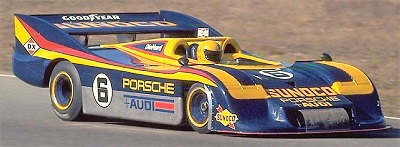
Can Am Series - Porche 917-30
to his safety seat, with his legs dangling outside the car. Amazingly, Donohue only suffered a broken leg. George Follmer, Donohue's old Trans-Am teammate, resumed testing the 917-10 while Donohue was recuperating. In classic Donohue style, Donohue said of Follmer testing his car: "It just doesn't feel right. Seeing another man driving your car, a car you know so well. I imagine it must feel like watching another man in bed with your wife." Porsche, Penske, and Donohue quickly started the development of
the 917-30, complete with a reworked aerodynamic "Paris" body and a 5.4-liter turbocharged Flat-12 engine. Donohue set the world closed-course speed record driving the Porsche 917-30 at the Talladega Super Speedway in Talladega, Alabama on August 9, 1975. His average speed around the 2.66-mile high-banked oval was 221.120 mph. Donohue held the world record for eleven years, until it was broken by Rick Mears at Michigan International Speedway. The 917-30 is referred to as the "Can-Am killer" as it dominated the competition, winning every race but one of the 1973
Can-Am championship, however, the SCCA imposed fuel limitations for all Can-Am races due to the existing Arab oil embargo. Because of this, Porsche and McLaren withdrew from the series. It generally is considered one of the most powerful and most dominant racing machines ever created. Donohue earned the nickname of "Captain Nice", and was known for his ability to set up his own race car and drive it consistently on the absolute limit. Donohue raced in the inaugural IROC series in 1973/74, racing identical, specially-prepped Porsche RSR's. Of the four-race series, Donohue won the first two races at Riverside and the final race of the year at Daytona. The only person to beat Donohue was his former Penske Trans-Am teammate, George Follmer. In winning the first IROC championship,
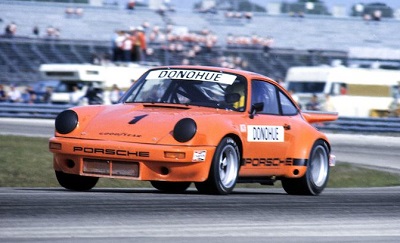
1974 IROC Series - Daytona
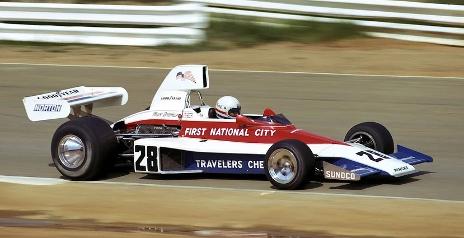
Formula 1 - 1975
Donohue beat the best-of-the-best racing drivers of that era from all of the major championships, such as Denny Hulme, Richard Petty, A.J. Foyt, Emerson Fittipaldi, Bobby Allison, David Pearson, Peter Revson, Bobby Unser, and Gordon Johncock. September 19, 1971 with a Penske-sponsored McLaren at the Canadian Grand Prix at Mosport Park, finishing on the podium in third place. After being lured out of retirement by his former boss, Penske, Donohue would return to Formula One, entering into the final two races of the 1974 Formula One season. Donohue finished in 12th place at the Canadian Grand Prix and failed to finish at the United States Grand Prix. A full-on assault
of the 1975 Formula One season was planned. The 1975 season turned out to be a difficult one for Donohue and Penske. Donohue was able to muster 5th place finishes at the Swedish Grand Prix and British Grand Prix, but the new Penske PC1 chassis proved problematic, as evidenced by three retirements in the first six races. At the Austrian Grand Prix; Donohue's career, along with Roger Penske's Formula One aspirations, would take a tragic turn. Midway through
the 1975 F1 season, Penske abandoned the troublesome PC1 and started using the March 751. Donohue had recently arrived in Austria for the Austrian Grand Prix at the Österreichring race track following the successful closed-course speed record attempt at Talladega Super Speedway in Alabama just a few days earlier. During a practice session for the race, Donohue lost control of his March after a tire failed, sending him careening into the catch fencing. Donohue's head was said to have struck either a catch fencing post, or the bottom of the wood frame for an advertising billboard located trackside. A track marshal was killed by debris from the accident, but Donohue did not appear to be injured significantly.
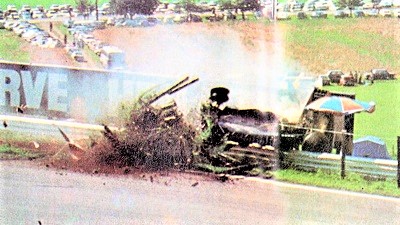
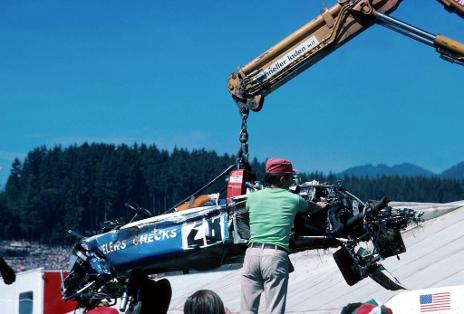
However, a resulting headache worsened and after going to the hospital of Graz the next day, Donohue lapsed into a coma from a cerebral brain hemorrhage and died. As for his Cup career, Donohue only raced in six Cup races. He won one race, never started worse than 12th and finished up at the front if he didn't have mechanical problems. Mark Donahue won the 1969 24 Hours of Daytona driving his 1969 Lola / Chevy. In 2009, exactly 40 years later on the anniversary of Mark's win; David Donahue; his son, also won the 24 hours of Daytona. Some info from Wikipedia
All Photos copyright and are property of their respective owners
